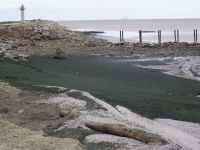
Western Lake Erie Waterkeeper Association
Lyngbya wollei - an algae that grows in the sediments and lasts through the winter
A THREAT TO THE WATER AND THE FISH
Lyngbya wollei is a tough, new invasive algae in Maumee Bay and the western shores of the Western Lake Erie watershed. Lyngbya multiplies rapidly in warm water and survives the winters - washing up on the shore green in the winter. Most think lyngbya arrived because the chemistry and water temperature changed and/or it came in on a recreational boat from Southeast US. Lyngbya is a great threat to western Lake Erie, home to the most fish in the Great Lakes.
Dr. John Rodgers of Clemson University calls it the “beast of water algae," stating "I consider it among the top ten worst environmental enemies I’ve seen in my 30-year career.”
Lyngbya wollei was first seen on the southern shores of Maumee Bay after a six day northeastern the week before Labor Day 2006. It now appears that it was growing on the northeastern shores of Maumee Bay in areas with thermally warmed water from two coal fired power plants that together use 2.2 billion gallons of water daily. The northeastern must have dislodged the lyngbya in massive amounts to the southern shores.
The lyngbya is now growing in the sediments on the southern shores of Maumee Bay and lyngbya is now found at the Lake Erie Islands.
Lyngbya, where it is growing, is different than Lake Erie algae. Lyngbya grows in the sediments. When growing it has to be pulled out of the sediments and is very dark and black like. Lyngbya that is not lodged in the sediments is green with matted hairs with little ball-like masses. The dislodged lyngbya grows on rock and sand.
When lyngbya blanketed the southern Maumee Bay shoreline in 2006, many thought it would die in the winter. It did not. The lyngbya algae rolled up on the shores in April 2007, and again rolled up in March 2008.
Lyngbya is growing now - August 2008 along the Maumee Bay shoreline.
Maumee Bay and the Maumee River are the most dredged areas in the Great Lakes. About 800,000 cubic yards of sediments are dredged and most is open lake dumped - in about 15-20' of water. The open lake disposed sediments travel as far as 100 miles to eastern Lake Erie(Reuter OSU Seagrant). Lyngbya may be spread with this practice.
Lyngbya wollei is reported as far as Reno Beach, about nine miles east of Maumee Bay State Park. It has been seen in Luna Pier and out in the bay around the shipping channel.
Lyngbya wollei is reportedly covering potions of the bottom of the bay and very western Lake Erie and is eliminating the aquatic life in the sediments. This dramatically reduces the food chain for the fish. There were very few mayflies along the shores of Maumee Bay in 2008 - there were many in 2007. The islands, Port Clinton and Sandusky all had good hatches. One sampler said there are very few mayfly larvae in the bay - a sign of trouble.
Sandy Bihn, on behalf of the Western Lake Erie Waterkeeper Association, has asked members of the Lake Erie Commission to ban open lake dumping of dredge materials in 2008 because open lake dumping will result in more rapid spreading of the Lyngbya in Lake Erie.
There are no efforts to control the spread of lyngbya in Maumee Bay and Western Lake Erie.
Note: The following Lyngbya information was obtained from people in North Carolina and Florida who began fighting Lyngbya in 2002, and those efforts continue today.
LYNGBYA LIKES
Warm Water
Calm Water
Thermally heated power plant outflow water
Sewage
Precluded niche which settles in the sediments
Urban runoff
Phosphorous
Nitrogen
Calcium
LYNGBYA DISLIKES
Native algae plants which can dominate and push it away
Circulating water
(Either of these can reduce or push out the Lyngbya)
GETTING RID OF LYNGBYA
Excavate it out of the water as leaving it in the water releases toxins
Formulate a special concoction approved for use in fresh water that kills the strain
HEALTH EFFECTS
Good news: no reported deaths from contact with Lyngbya
Can cause rashes
Continuous contact can reduce some immune functions in that area
PLEASE CALL LOCAL, STATE AND FEDERAL ELECTED OFFICIALS AND ASK THAT OPEN LAKE DUMPING BE BANNED IN 2008 & FOR A SURVEY AND TESTING OF THE LYNGBYA TO DETERMINE HOW TO KILL IT AND STOP IT FROM SPREADING
Click here (.doc) for a statement that Sandy Bihn made to the Lake Erie Commission.
Photos of the algae (.ppt)
Edward J. Phlips, Jean Ihnat, and Mike Conroy, "Nitrogen fixation by the benthic freshwater cyanobacterium Lyngbya wollei" (abstract and .pdf for purchase)
WW Carmichael et al, "Evidence for paralytic shellfish poisons in the freshwater cyanobacterium Lyngbya wollei" (abstract and link to free full text)
(.pdf)
North Carolina has been dealing with Lyngbya wollei (or, woolei) for years. Please see:
This information is important to share with others who are concerned about Lake Erie.
Western Lake Erie: The Warmest, Shallowest, "Fishiest" Area of the Great Lakes
To learn more about the Waterkeeper Alliance, click here.
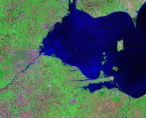
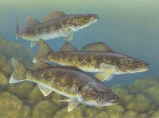
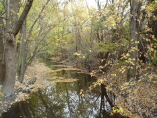
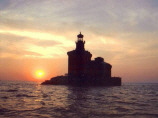
~ Currents ~
